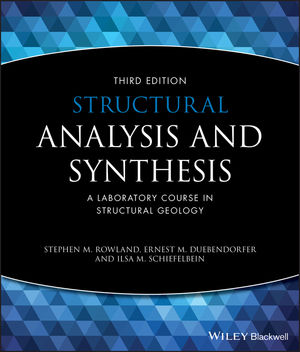|
Looseleaf
Structural Analysis and Synthesis: A Laboratory Course in Structural Geology, 3rd EditionISBN: 978-1-4051-1652-7
Loose-leaf
320 pages
January 2007, Wiley-Blackwell
 This title is out-of-print and not currently available for purchase from this site.
|
Read this First.
1. Attitudes of Lines and Planes.
Objectives.
Apparent-dip problems.
Orthographic projection.
Trigonometric solutions.
Alignment diagrams.
2. Outcrop Patterns and Structure Contours.
Objectives.
Structure contours.
The three-point problem.
Determining outcrop patterns with structure contours.
Bree Creek Quadrangle map.
3. Interpretation of Geologic Maps.
Objectives.
Determining exact attitudes from outcrop patterns.
Determining stratigraphic thickness in flat terrain.
Determining stratigraphic thickness on slopes.
Determining stratigraphic thickness by orthographic projection.
Determining the nature of contacts.
Constructing a stratigraphic column.
4. Geologic Structure Sections.
Objective.
Structure sections of folded layers.
Structure sections of intrusive bodies.
The arc method.
Drawing a topographic profile.
Structure-section format.
5. Stereographic Projection.
Objective.
A plane.
A line.
Pole of a plane.
Line of intersection of two planes.
Angles within a plane.
True dip from strike and apparent dip.
Strike and dip from two apparent dips.
Rotation of lines.
The two-tilt problem.
Cones: the drill-hole problem.
6. Folds.
Objectives.
Fold classification based on dip isogons.
Outcrop patterns of folds.
Down-plunge viewing.
7. Stereographic Analysis of Folded Rocks.
Objectives.
Beta diagrams.
Pi diagrams.
Determining the orientation of the axial plane.
Constructing the profile of a fold exposed in flat terrain.
Simple equal-area diagrams of fold orientation.
Contour diagrams.
Determining the Fold style and interlimb angle from contoured pi diagrams.
8. Parasitic Folds, Axial-Planar Foliations, and Superposed Folds.
Objectives.
Parastic folds.
Axial-planar foliations.
Superposed folds.
9. Faults.
Objectives.
Measuring slip.
Rotational (scissor) faulting.
Tilting of fault blocks.
Map patterns of faults.
Timing of faults.
10. Dynamic and Kinematic Analysis of Faults.
Objectives.
Dynamic analysis.
Kinematic analysis.
11. A Structural Synthesis.
Objective.
Structural synthesis of the Bree Creek Quadrangle.
Writing style.
Common errors in geologic reports.
12. Rheologic Models.
Objective.
Equipment required for this chapter.
Elastic deformation: instantaneous, recoverable strain.
Viscous deformation: continuous strain under any stress.
Plastic deformation: continuous strain above a yield stress.
Elasticoplastic deformation.
Elasticoviscous deformation.
Firmoviscous deformation.
Within every rock is a little dashpot.
13. Brittle Failure.
Objective.
Equipment required for this chapter.
Quantifying two-dimensional stress.
The Mohr diagram.
The Mohr circle of stress.
The failure envelope.
The importance of pore pressure.
14. Strain Measurement.
Objectives.
Equipment required for this chapter.
Longitudinal strain.
Shear strain.
The strain ellipse.
Three strain fields.
The coaxial deformation path.
The coaxial total strain ellipse.
Noncoaxial strain.
The noncoaxial total strain ellipse.
Deformed fossils as strain indicators.
Strain in three dimensions.
Quantifying the strain ellipsoid.
15. Construction of Balanced Cross Sections.
Objectives.
Thrust-belt “rules”.
Recognizing ramps and flats.
Relations between folds and thrusts.
Requirements of a balanced cross section.
Constructing a restored cross section.
Constructing a balanced cross section.
16. Deformation Mechanisms and Microstructures.
Objectives.
Deformation mechanisms.
Fault rocks.
Kinemative indicators.
S-C fabrics.
Asymmetric porphyroclasts.
Oblique grain shapes in recrystallized quartz aggregates.
Antithetic shears.
17. Introduction to Plate Tectonics.
Objectives.
Fundamental principles.
Plate boundaries.
Triple junctions.
Focal-mechanism solutions (“beach-ball” diagrams).
Earth magnetism.
Apparent polar wander.
Appendices.
A: Measuring attitudes with a Brunton compass.
B: Geologic timescale.
C: Greek letters and their use in this book.
D: Graph for determining exaggerated dips on structure sections with vertical exaggeration.
E: Conversion factors.
F: Common symbols used on geologic maps.
G: Diagrams for use in problems.
References.
Further Reading.
Index



